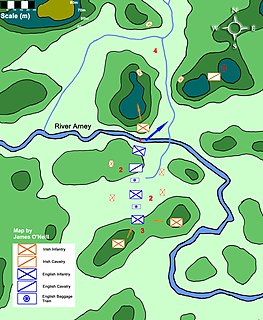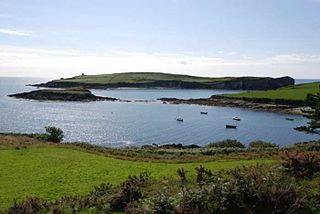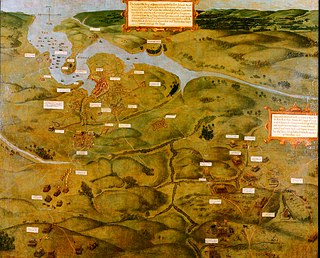 W
WOn 16 February 1595, a Gaelic Irish force assaulted and captured the English-held Blackwater Fort at Blackwatertown in County Armagh. The Irish were led by Art MacBaron O'Neill, brother of Hugh O'Neill, Earl of Tyrone, and marked Tyrone's break with the English Crown as he openly waged war against the English forces in Ireland.
 W
WThe Battle of the Ford of the Biscuits took place in Fermanagh, Ireland on 7 August 1594, during the Nine Years' War. A column of almost 650 English troops led by Sir Henry Duke was ambushed and defeated by a Gaelic Irish force under Hugh Maguire and Cormac MacBaron O'Neill at the Arney River. The English column had been sent to relieve and resupply Enniskillen Castle, which had been under siege by the Irish since May. The English suffered at least 56 killed and 69 wounded, and were forced to make a hasty retreat.
 W
WThe Siege of Cahir Castle took place in Munster, in southern Ireland in 1599, during the campaign of the Earl of Essex against the rebels in the Nine Years War (1595-1603). Although the castle was considered the strongest fortress in the country, Essex took it after only a few days of artillery bombardment. However, Queen Elizabeth dismissed her commander's achievement, claiming the defenders were merely a "rabble of rogues".
 W
WThe Battle of Carrickfergus took place in November 1597, in the province of Ulster in what is now County Antrim, Northern Ireland, during the Nine Years War. It was fought between the crown forces of Queen Elizabeth I and the Gaelic clan of MacDonnell, with military support from Hugh O'Neill, earl of Tyrone, and resulted in a defeat for the English.
 W
WThe Battle of Castlehaven was a naval battle that took place on 6 December 1601 in the bay off Castlehaven on the south coast of Ireland during the Nine Years' War between a Spanish naval convoy of six ships and an English fleet, commanded by Admiral Richard Leveson and consisting of four warships. The Spanish convoy was protected by fortified positions on shore, a castle, and 600 Spanish and Irish footmen. Five out of six Spanish ships, commanded by General Pedro de Zubiaur were either sunk, captured, or run aground in the battle, while the English fleet lost no ships.
 W
WThe Battle of Clontibret was fought in County Monaghan in May 1595, during the Nine Years' War in Ireland. A column of 1,750 English troops led by Henry Bagenal was ambushed near Clontibret by a larger Gaelic Irish army led by Hugh O'Neill, Earl of Tyrone. The English column had been sent to relieve the besieged English garrison at Monaghan Castle. The English suffered very heavy losses, but a suicidal cavalry charge apparently saved it from destruction. The Irish victory shocked the English and was their first severe setback during the war.
 W
WThe Battle of Curlew Pass was fought on 15 August 1599, during the campaign of the Earl of Essex in the Nine Years' War, between an English force under Sir Conyers Clifford and a rebel Irish force led by Aodh Ruadh Ó Domhnaill. The English were ambushed and routed while marching through a pass in the Curlew Mountains, near the town of Boyle, in the west of Ireland. The English forces suffered heavy casualties. Losses by allied Irish forces were not recorded but were probably minimal.
 W
WThe Siege of Donegal took place in August 1601 during the Nine Years' War in Ireland, when a Gaelic Irish army led by Hugh Roe O'Donnell laid siege to the town of Donegal. The garrison of the town was a mixture of English troops and allied Gaelic troops led by Niall Garve O'Donnell. Heavy fighting took place during the month-long siege in which Donegal Abbey was destroyed by an accidental gunpowder explosion. Having suffered several repulses, Hugh Roe O'Donnell abandoned the siege and moved his army southwards to Munster to take part in the Battle of Kinsale. In his absence, Crown forces were able to use Donegal as a base to capture the strategic town of Ballyshannon.
 W
WThe siege of Dunboy took place at Dunboy Castle between 5 June and 18 June 1602, during the Nine Years' War in Ireland. It was one of the last battles of the war. An English army of up to 5,000 under George Carew besieged the castle, which was held by a Gaelic Irish force of 143 loyal to Donal Cam O'Sullivan Beare. The English took the castle after eleven days and most of the survivors were hanged. The English also captured a fort on nearby Dursey Island.
 W
WThe Dursey massacre, also called the Dursey Island massacre, took place in June 1602 during the Nine Years' War on Dursey Island off the Beara Peninsula in southern Ireland. According to Philip O'Sullivan Beare, a group of around three hundred Gaelic Irish, including civilians, were killed by English soldiers under George Carew.
 W
WThe Siege of Enniskillen took place at Enniskillen in Fermanagh, Ireland, in 1594 and 1595, during the Nine Years' War. In February 1594, the English had captured Enniskillen Castle from the Irish after a waterborne assault and massacred the defenders after they surrendered. From May 1594, an Irish army under Hugh Maguire and Cormac MacBaron O'Neill besieged the English garrison in the castle, and in August they defeated an English relief force. A second relief force was allowed to resupply the garrison, but the castle remained cut off. Eventually, in May 1595, the English garrison surrendered to the Irish and were then executed.
 W
WThe siege of Kinsale, or Battle of Kinsale, was the ultimate battle in England's conquest of Gaelic Ireland, commencing in October 1601, near the end of the reign of Queen Elizabeth I, and at the climax of the Nine Years' War—a campaign by Hugh O'Neill, Hugh Roe O'Donnell and other Irish lords against English rule.
 W
WThe Battle of the Yellow Ford was fought in County Armagh on 14 August 1598, during the Nine Years' War in Ireland. An English army of about 4,000, led by Henry Bagenal, was sent from the Pale to relieve the besieged Blackwater Fort. Marching from Armagh to the Blackwater, the column was routed by a Gaelic Irish army under Hugh O'Neill of Tyrone. O'Neill's forces divided the English column and a large earthwork stalled its advance. Bagenal was killed by an Irish musketeer, and scores of his men were killed and wounded when the English gunpowder wagon exploded. About 1,500 of the English army were killed and 300 deserted. After the battle, the Blackwater Fort surrendered to O'Neill. The battle marked an escalation in the war, as the English Crown greatly bolstered its military forces in Ireland, and many Irish lords who had been neutral joined O'Neill's alliance.